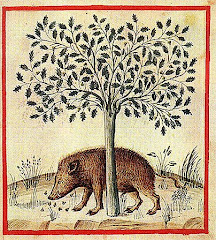"Lovely blanket! I have to ask, did you dye the wool yourself?"

Thanks Debs, and the answer is "sort of". Much of the wool was a combined effort from several occasions over a couple of years. The majority was dyed on two separate dyeing days in Northern Sweden, events my mother and I have taken to attending as often as possible.
These days, held at Brynge Kulturområde (heritage museum featuring traditional linen manufacture and Smithy) near Örnsköldsvik, are what introduced us to the wonderful world of natural dyeing - something I had wanted to try for a long time.
The back-to-nature disregard for British ideas of health and safety makes these days all the more enjoyable. Wandering bare foot between 6 - 10 small cauldrons, stoking fires, stirring plant stuff and dipping wool, we've had a fantastic, albeit exhausting time, when we've been.

And the location is perfect. Apart from the green grass and nearby cafe selling home-made Swedish cinnamon buns, a final rinse of each hank involves clambering down to the waters edge and allowing the current of the water to pull away the last bits of plant material and excess dye.
All the wool tends to be mordanted with alum in advance, or alum is added to the dyebath. Inger, who runs these events, also brings an iron pot for further experimentation with colour.
The plants we use generally come from the surrounding woods and ditches or are brought by Inger and other participants. We're guaranteed to do an onion (Allium cepa) skin bath because of the beautiful yellow it gives, and baths of madder (Rubia tinctorum), Brazilwood (Caesalpinia echinata) and logwood (Haematoxylum campechianum) are also often included for a bit of the exotic. Other than that, we've stuck to nordic favourites such as birch (Betula sp.), meadowsweet (Filipendula ulmaria) and heather (Calluna vulgaris).
As the day progresses, more and more hanks are added to the line which encourages museum visitors to come and see what we're up to.






















5 comments:
Thanks for telling me about your blog Kristina, its great! I've not played with dyes much but hope to grow dye herbs this summer.
Cindy
Sagescript Institute
I came here from MyBlogLog. Awesome blog, beautiful pics and great content. I'll definitely be following your progress.
Kristina I'm totally envious and very impressed, what stunning colours and such wonderful photos. Have you ever thought of running a UK herbal dyeing workshop? I'm potting on my indigo seedlings tomorrow and sowing some safflower and a couple of other dye plants to go with what I already have, my experiments will be on material to begin with, although I dream of being able to dye my own wool and then knit something creative with the finished results. Keep the herbal dyeing info coming :)
D x
I love your blanket, Kristina! Have you had to wash it and would it run?
Yes I have hand-washed it a couple of times now and it hasn't run at all.
I usually use a small quantity of Ecover detergent because it's so mild although there are purpose made soaps out there too.
In the final rinse I add a small dollop of vinegar to keep the dyes fixed so the blanket does have a slightly tangy/sheepy smell to it which I wasn't sure about at first, but now decided I quite like after all.
Post a Comment